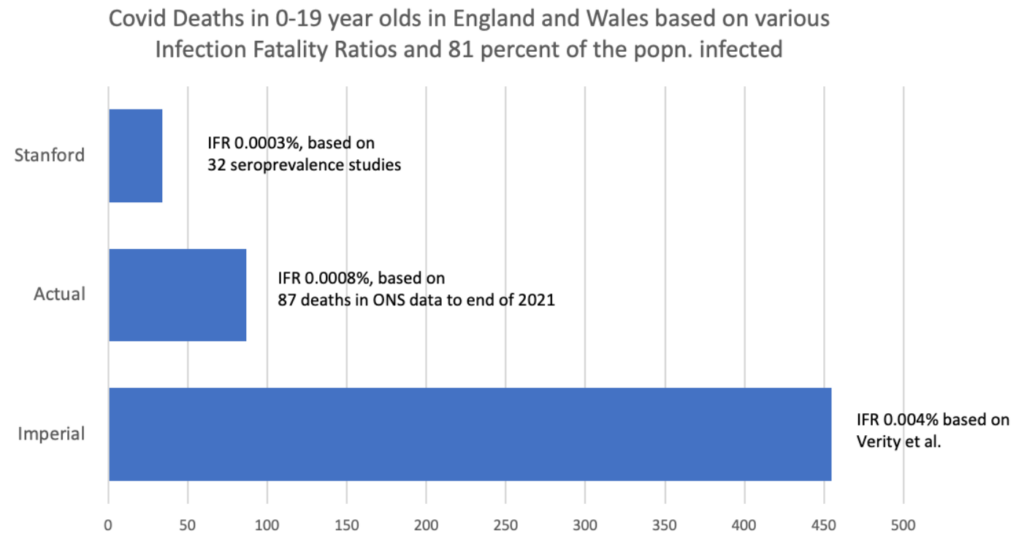The Infection Fatality Ratio (IFR) estimates the percentage deaths in all those with an infection: the detected (cases) and those with undetected disease (asymptomatic and the not-tested group).
The IFR is used to model the estimated number of deaths in the population at large. If it’s a large number approaching 1%, then the modelled outputs can report an alarming number of fatalities – providing the impetus for lockdowns.
Early in the pandemic, Imperial College London’s Report 9 modelled the impact of Covid based on a publication by Verity et al. on March 13th 2020, which estimated the IFR as 0.9%.
This IFR gave rise to the modelled estimates that “in an unmitigated epidemic, we would predict approximately 510,000 deaths in Great Britain and 2.2 million in the U.S.”.
The authors wrote this: “However, the resulting mitigated epidemic would still likely result in hundreds of thousands of deaths and health systems (most notably intensive care units) being overwhelmed many times over. For countries able to achieve it, this leaves suppression as the preferred policy option.”
A recent publication by Stanford researchers based on seroprevalence studies in the Covid pre-vaccination era provides a more robust estimate of the IFR.
Across 32 studies, the median IFR of COVID-19 was estimated to be 0.035% for people aged 0-59 years and 0.095% for those aged 0-69.
We compared the two IFR estimates, which shows the Imperial College estimates are much higher than Stanford’s across the age groups.

Estimating IFR in the early stage of outbreaks is so error-prone that it should come with a warning. Antibody studies provide a more accurate understanding of how many people have been infected and permit a more precise estimate of the IFR. However, early in the pandemic, such studies are not available – Verity et al. based their IFR on Chinese data and just 1,334 cases outside mainland China. The case fatality ratio was estimated on just one severe case in those under 19.
Instead of early models and predictions, an alternative strategy is to analyse the data as they emerge: work out what is going on. We did this, and by April 2020 we wrote that it was increasingly clear that the “age affected structure doesn’t fit with pandemic theory”.
The early IFR estimates from Imperial College were substantially overestimated across the ages compared to Stanford’s seroprevalence studies – more than ten-fold in those under 19. But how do they compare with the actual data?
Imperial College predicted that 81% of the Great British population would be infected throughout the epidemic. By December 31st 2021, the ONS infection survey estimated that 81% of England’s population had COVID-19. ONS reports 87 registered deaths in 0 to 19-year-olds in England and Wales by this date.
We used these data to back-calculate the IFR in the 0-19-year-olds based on 11.36 million (81% of the population) in this age group infected by the end of 2021. This gave an IFR estimate of 0.0008% (see figure).

The consequences of overestimating the IFR are profound. It overpredicts the number of deaths and influences political decision-making without considering the long-term harm and well-being effects.
Overestimating the IFR is not that unusual. For example, in the Swine Flu pandemic, the post-pandemic IFR was reported as 0.02%, fivefold less than the lowest estimate during the outbreak.
There are further problems with the IFR to consider. First, it assumes all deaths with a PCR positive test or Covid on the death certificate were caused by SARS-CoV-2. This Is not the case, as we have shown. The IFR also doesn’t account for hospital deaths or the complex interaction of multimorbidity (underlying conditions) and the assignment of causation.
An analysis distinguishing causation in under 18s, as opposed to those who died of another cause but were coincidentally infected, reported a mortality rate in under-18-year-olds of two per million – an IFR of 0.0002%, 20-fold lower than Imperial’s estimate for under-19s. This suggests Covid is the underlying cause of death in only about a quarter of young people when it is registered on the death certificate.
Invoking the precautionary principle for the widespread use of restrictions based on catastrophic predictions also underlines the misunderstanding of that principle, which is to act only when you are sure that the benefits of your actions outweigh the negative consequences. No evidence of this existed in March 2020, as lockdowns were not even contemplated in the existing pandemic plans.
Dr. Carl Heneghan is the Oxford Professor of Evidence Based Medicine. Dr. Tom Jefferson is an epidemiologist based in Rome who works with Professor Heneghan on the Cochrane Collaboration. Dr. Jason Oke is a senior medical statistician, university lecturer and researcher with an interest in diagnostics and monitoring. This article was first published on their Substack page, which you can subscribe to here.












To join in with the discussion please make a donation to The Daily Sceptic.
Profanity and abuse will be removed and may lead to a permanent ban.
Indeed, Professor Pantsdown has a LOT to answer for!
I fear for Ferguson when the retribution gets underway. And for Drosten in Berlin. All their filthy lucre won’t save them.
I fear for his soul. I suspect his temporal assets will see him through this life.
When you see him in person and are informed that he sleeps beneath a stone you find that it is impossible to disbelieve it. There’s an air of a salamander about him.
Even more so the numbskulls who decided to use his totally inaccurate forecasts, based on schoolboy coding, with a consistent and well-known record of previous failures. That decision was the ground zero for all the consequent hysteria. So will the public inquiry identify who was responsible and why Pantsdown was employed? Not a chance unfortunately. The guilty party will get away with their gross incompetence. But never mind, they only trashed the economic and educational well being of the Western world, with the honourable exception of Sweden.
And lest we forget the atrocious track record of that seemingly untouchable epic failure that is Ferguson, this article summarises;
https://www.dougmichaeltruth.com/professor-fergusons-dismal-track-record-for-predicting-fatalities-with-faulty-and-outdated-computer-modelling/
I am just disappointed the authors did not reiterate the petri dish aka something like the Diamond Princess moored up at sea. To me that was very early evidence of the actual risks of covid 19, both spread and IFR, which was ignored by far too many so called experts.
And the aircraft carriers Charles de Gaulle and Teddy Roosevelt. These had a younger population than the Diamond Princess, but not a single fatality.
Dr Fauci also mis-stated the IFR as 3% in Congressional hearings. He was forced to withdraw that later, but the harm had been done.
While grateful to these authors for pointing out these figures, there’s nothing here that many of us weren’t broadly aware of back in March 2020.
It was always clearly that the Imperial models were grossly incorrect, designed to scare, and almost certainly paid to present forward the results they did.
It serves at least one purpose. It exposes for the millionth time the mendacity of the MSM.
In a different time this would have been reported and it would have been big news. Because it is.
But crickets, as always.
It’s there for those still clinging on to the cock up theory to see whenever they want to and are prepared to accept the reality of the world.
2 years, 20.000 dead FROM not with Rona. Less than the average flu year which disappeared.
The authors are counting WITH fake tests and hand waving. PCR tests are an outrageous fraud and pick up nothing.
And it still amazes me that people don’t know the MCCD was changed in March 2020.
You don’t need 2 doctors and medical proof to cite cause of death. Hand waving, fake tests, even a doctor who did not know the deceased can infill cause of death. Rona meant money. Every Rona death was paid. Every stab, test, bed, incident received money. What do you think the Death Care systems are going to do but overcount everything?
What was the excuse for the foot in mouth cattle slaughter I wonder?
The whole notion that computer simulations, especially complicated computer simulations, can be used to predict the future is no more sensible than trying to do the same based on examining the guts of sacrificed animals in order to accomplish that. A piece of software is said to be correct when the postconditions are true after it was executed, provided the preconditions were true before execution started and the invariant conditions remained true during execution. Ie, the very defintion of software correctness requires that the intended outcome of executing it is known beforehand. Correctness of such a computer simulation is thus impossible to establish, hence, errors in the code – which will on average appear with a certain known density per line of source – cannot possibly be corrected.
This is literally nothing but complicated humbug charlatans make a comfortable living from.
A good description; it’s more like a weather forecasting model, rather than any kind of high safety integrity control system. In his case, the Safety Integrity Level (SIL) is almost certainly zero! They were guessing, with an academic gadget to justify the output.
Similar supposedly predictive computer simulations suffer from the same general problem. I’ll try to put this a little more into plain language in the hope to make the complete lunacy of this a bit more understandable.
Let’s assume a classic, simple problem: Sort a list of words alphabetically. The intended outcome is known, namely, an alphabetically sorted list. One can thus come up with an algorithm supposed to accomplish this and verify that both the algorithm and its specific implementation actually work by comparing the actual outcome with the intended outcome. Initially, either algorithm or implementation will likely not work (often both). But since this can be determined, it’s possible correct these errors. This is obviously vastly oversimplified.
But the intended outcome of a predictive simulation program is not known because if we knew it, we wouldn’t need the program. Hence, whoever designs and writes the simulation first comes up with an inherently unverifiable theory how this algorithm really ought to work and then implements that. There is no functional specification which could be used to determine that the implementation of the algorithm isn’t correct as the functional specification has been supplanted by a castle-in-the-air. And there’s certainly no way to determine if this castle-in-the-air is actually a really workable castle-in-the-air (so to say) because castles-in-the-air don’t exist.
Things are a little better for weather simulation programs, because these can at least be corrected heuristically: Assuming the actual weather differs from the predicted weather, one can try to tune the algorithm to correct this problem. But the best outcome here is an algorithm which would have predicted all past weather correctly it actually mispredicted. This doesn’t mean there’s ever a guarantee that it’ll predict the weather of tomorrow correctly.
Not even this option is available for pandemic simulation programs because the turnaround time (time the cycle write program, observe pandemic, tweak program, observe next pandemic takes) is much too long to come up with a workable heuristic within a reasonable time.
A useless academic gadget?
The simple answer is that if computer models had ANY predictive power, someone would have quickly applied it to the stockmarket and become the richest person on earth.
The fact that that hasn’t happened yet, says it all.
People are applying this to the stock market all the time. But this only becomes publically known when the outcome is a serious f**k-up, eg, 2008.
No, they’re not. Even the smallest reliable statistical edge could be compounded until there was no more money left for anyone else. No one can model fear, greed and human psychology on a computer. They want people to believe that they can to attract the mug punters money, that’s all.
Not only was Ferguson useless at his job he was also banging his mistress (probably badly) when he expected the rest of us to live under effective house arrest. Nebuchadnezzar executed his wizards in the Bible story, a great shame Ferguson won’t meet a similar end, it would be totally deserved.
It is possible to see how preposterous the forecasts were by looking at the number of deaths per day forecast during May 2020. Around 14,000 deaths per day in a country with less than 1% of the World’s population. The highest global daily death toll per Worldometers is just shy of 17,000.
Brian Catt on a podcast with Tom Nelson uses the error measurement for the factor that a model differs from reality as “a Ferguson”. Funny!
For most models it would be a fraction of a Ferguson.
Just remember that I am the only person on planet earth (population 800,000,000,000) who correctly diagnosed Covid 19 in March 2020 as an imaginary virus and that the REAL illness was actually a collective mental illness known as Mass Psychosis.
I thought someone else would have worked it out by now but, as even the most skeptical skeptic believes it to be real, it’s probably going to take decades..
Not to worry, I’m patient and as Charles Mackay famously said in 1841:
“Men, it has been well said, think in herds; it will be seen that they go mad in herds, while they only recover their senses slowly, one by one”
7,983,990,011
According to Worldometer. Although that is obviously already out of date and was only an estimate anyway. I love some of the population and land mass estimates from the 1906 encyclopaedia!
There was the evidence of the Diamond Princess, where about 7 people out of 3,500 died. Over half of those (ie the passengers, not the crew) would have been in the vulnerable category due to age, infirmity etc.
The Government downgraded Covid to a Low Consequence Infectious Disease with low mortality rates roughly a week BEFORE the first lockdown was imposed.
So they knew Ferguson’s predictions were wrong…. but they did it anyway.
What we need to know is WHY.
Why? because they were suffering from hysteria, the starting point of a Mass Psychosis outbreak. When in that state facts become meaningless and fear drives the decisions. Then confirmation bias steers them towards those that confirm those fears (Fergusson) and causes them to ignore those that don’t confirm those fears (Ioannidis).
The blue touch paper was lit by Fergusson and his cronies and the rest is history.
Prof Neil Flipwit Ferguson never could add up. Once the establishment has adopted you as one of its “experts”, you are treated like a demigod regardless of actual scientific ability. Critical scrutiny is simply not part of Whitehall’s DNA so there is no accountability. I have concluded that Ferguson is sincerely deluded that he did a good job during lockdown.Who has told him otherwise apart from fringe types such as ourselves.